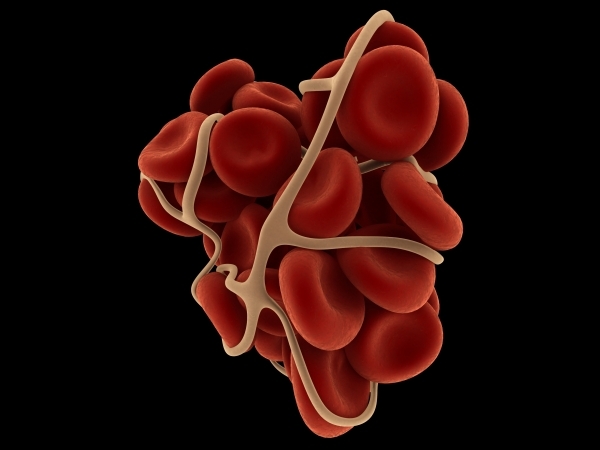Blood clots can surprise through genetic conditions, lifestyle habits
It's estimated that about 100,000 deaths occur each year in the U.S. from blood clots, while these clumps of sticky blood also play a contributing factor in an additional 100,000 deaths annually, according to medical statistics. It's also estimated on average 800,000 people, at any one time, are diagnosed with venous thrombosis, the most common form of blood clots that park themselves in the legs.
Dr. Fadi Shamoun, medical director of the Anticoagulation Clinic and Vascular Medicine Division of Cardiovascular Diseases at the Mayo Clinic in Scottsdale, Ariz., said blood clots can be attributed to two factors: external and internal.
External factors would be after a person has undergone a major surgery, confined in bed for an extended period, traveling extensively by air or land vehicle, undergoing cancer therapy or if a person is obese.
Internal factors would be genetic disorders such as Factor V Leiden, where there is a mutation in one of the clotting factors in the blood. Shamoun said this condition exists in 5 percent to 6 percent of the Caucasian population.
Another common disorder is prothrombin G20210A, a genetic variant that doubles or triples the risk of forming blood clots in the veins. A third internal problem would exist when deficiencies in two anticoagulants, Protein S and Protein C, exists. Shamoun said this condition commonly occurs in the African-American and Asian populations.
Blood clots occur in the body's venous system, the blood vessels that deliver blood back to the heart. Clots that occur in the lower pelvic area such as the legs are called deep vein thrombosis or DVT. These usually occur when a person has been hospitalized after surgery.
"If you don't contract your muscles they form blood pools," said Trish Strobehn, nurse practitioner in the Emergency Department at University Medical Center. "They also may occur when people have the flu and remain in bed for a while."
When blood clots remain in the lower regions of the body they pose no danger and are treated with medications such as blood thinners. If a blood clot starts to move and travels to your lungs, then a potentially life-threatening condition called pulmonary embolism exists where it could travel to your heart and block blood flow resulting in death. If it travels to the brain, then a blockage in the small arteries of the brain called a cerebral embolism could cause an embolic stroke.
Some common symptoms associated with blood clots include swelling if the clot is in the leg or ankle, fever if the clot is on the move through the bloodstream, redness near the location of the blood clot, pain when walking, dizziness, shortness of breath if the clot has moved closer to your lungs, sudden coughing or coughing up blood-stained mucous or constant fatigue.
Strobehn said anticoagulant therapy is normally prescribed to break up blood clots, and if clots are severe a person would be hospitalized and placed on a drip system to dissolve the clots. She said it usually takes from a few weeks to as long as six months and in some cases 12 months to dissolve some blood clots.
"Once you have had blood clots, it increased your chances of getting more," Strobehn said. "Some people have to have filters put in their veins."
The elderly are most at risk for getting blood clots if they live a sedentary lifestyle or they fall and break a bone. Pregnant women are also at risk because their blood thickens during pregnancy.
"Once we cross the age of 40 the risk of blood clots increases," Shamoun said. "It is definitely an age-related problem. … For some reason, people in Southeast Asia have less risk and diet doesn't impact much."
Shamoun also points out that a third to half of people who experience blood clots will have significant damage to their veins. The chances for vein damage occurs when the clots are higher up, such as in the groin area, the doctor said. Such damage would be swelling of the vein or there may be a brown discoloration in the affected area.
Shamoun said the protocol for treatment when a person is suspected of having a blood clot is to first conduct a physical and go over the person's medical history. A blood test is then administered and an ultrasound performed, if the clot is suspected to be in the lower pelvic area.
A CT scan should be done of the abdomen and chest area, Shamoun said. X-rays will not show if a blood clot has formed. Shamoun said that blood thinners are the best treatment for dissolving blood clots.
"Once you have had a clot, be sure to mention it if you have to go to the emergency room," Shamoun said. "Patients who get blood clots in the legs should wear compression stockings and wear them until they do a follow-up with their physician."
With proper diagnosis and treatment, Shamoun and Strobehn said blood clots can be dissolved successfully. Leading a nonsedentary lifestyle and controlling one's weight so blood circulation isn't impaired greatly helps, too.
Shamoun said having cancer significantly raises the threat of blood clot formations, as does women undergoing hormone replacement therapy or taking oral contraception medicines. Surgery raises the risk, as does trauma to the body.
"There are several studies showing that a patient who has had a clot once in their life has a 30 percent chance of having them again in the next 10 years …," Shamoun said. "The size of the blood clot and the age of the person is very important."































